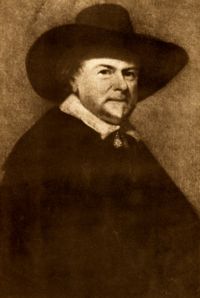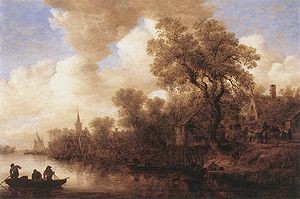
Jan van Goyen
Encyclopedia

Biography
Jan van Goyen was the son of a shoemaker and started as an apprentice in Leiden, the town of his birth. Like many DutchNetherlands
The Netherlands is a constituent country of the Kingdom of the Netherlands, located mainly in North-West Europe and with several islands in the Caribbean. Mainland Netherlands borders the North Sea to the north and west, Belgium to the south, and Germany to the east, and shares maritime borders...
painters of his time, Jan van Goyen studied art in the town of Haarlem
Haarlem
Haarlem is a municipality and a city in the Netherlands. It is the capital of the province of North Holland, the northern half of Holland, which at one time was the most powerful of the seven provinces of the Dutch Republic...
with Esaias van de Velde
Esaias van de Velde
Esaias van de Velde was a Dutch landscape painter.-Biography:Born in Amsterdam, where his Flemish father Hans had fled as a Protestant in 1585, he probably studied under his father and Gillis van Coninxloo, a landscape painter from Antwerp and a follower of Pieter Brueghel the Elder...
. At age 35, he established a permanent studio at Den Haag (The Hague). Crenshaw tells (and mentions the sources) that Van Goyen's landscape paintings rarely fetched high prices, but he made up for the modest value of individual pieces by increasing his production, painting thinly and quickly with a limited palette of inexpensive pigments. Despite his market innovations, he always sought more income, not only through related work as an art dealer and auctioneer but also by speculating in tulips and real estate. Although the latter was usually a safe avenue of investing money, in Van Goyen's experience it led to enormous debts. Paulus Potter
Paulus Potter
Paulus Potter was a Dutch painter, specialized in animals in landscapes, usually with a low point of view. Before Potter died of tuberculosis, 28-years old, he succeeded in producing about a hundred paintings, working continuously.-Life:Few details are known of Potter's life...
rented one of his houses. Nicolaes van Berchem became his pupil.
In 1652 and 1654 he was forced to sell his collection of paintings and graphic art, and he subsequently moved to a smaller house. He died in 1656 in The Hague, still unbelievably 18,000 guilders in debt, forcing his widow to sell their remaining furniture and paintings. Van Goyen's troubles also may have affected the early business prospects of his student and son-in-law Jan Steen
Jan Steen
Jan Havickszoon Steen was a Dutch genre painter of the 17th century . Psychological insight, sense of humour and abundance of colour are marks of his trade.-Life:...
, who left The Hague in 1654.
Dutch painting

Dutch Golden Age
The Golden Age was a period in Dutch history, roughly spanning the 17th century, in which Dutch trade, science, military and art were among the most acclaimed in the world. The first half is characterised by the Eighty Years' War till 1648...
) will fall into one of four categories, a painter of portrait
Portrait
thumb|250px|right|Portrait of [[Thomas Jefferson]] by [[Rembrandt Peale]], 1805. [[New-York Historical Society]].A portrait is a painting, photograph, sculpture, or other artistic representation of a person, in which the face and its expression is predominant. The intent is to display the likeness,...
s, landscape
Landscape art
Landscape art is a term that covers the depiction of natural scenery such as mountains, valleys, trees, rivers, and forests, and especially art where the main subject is a wide view, with its elements arranged into a coherent composition. In other works landscape backgrounds for figures can still...
s, still-lifes, or genre
Genre
Genre , Greek: genos, γένος) is the term for any category of literature or other forms of art or culture, e.g. music, and in general, any type of discourse, whether written or spoken, audial or visual, based on some set of stylistic criteria. Genres are formed by conventions that change over time...
. Dutch painting was highly specialized and rarely could an artist hope to achieve greatness in more than one area in a lifetime of painting. Jan van Goyen would be classified primarily as a landscape artist with an eye for the genre subjects of everyday life. He painted many of the canals in and around Den Haag as well as the villages surrounding countryside of Delft
Delft
Delft is a city and municipality in the province of South Holland , the Netherlands. It is located between Rotterdam and The Hague....
, Rotterdam
Rotterdam
Rotterdam is the second-largest city in the Netherlands and one of the largest ports in the world. Starting as a dam on the Rotte river, Rotterdam has grown into a major international commercial centre...
, Leiden, and Gouda
Gouda
Gouda is a city and municipality in the western Netherlands, in the province of South Holland. Gouda, which was granted city rights in 1272, is famous for its Gouda cheese, smoking pipes, and 15th-century city hall....
. Other popular Dutch landscape painters of the sixteenth and seventeenth century were
Jacob van Ruisdael, Aelbert Cuyp
Aelbert Cuyp
Aelbert Jacobsz Cuyp was one of the leading Dutch landscape painters of the Dutch Golden Age in the 17th century. The most famous of a family of painters, the pupil of his father Jacob Gerritsz...
, Hendrick Avercamp
Hendrick Avercamp
Hendrick Avercamp was a Dutch painter.Avercamp was born in Amsterdam, where he studied with the Danish-born portrait painter Pieter Isaacks , and perhaps also with David Vinckboons. In 1608 he moved from Amsterdam to Kampen in the province of Overijssel...
, Ludolf Backhuysen
Ludolf Backhuysen
Ludolf Bakhuizen was a German-born Dutch Golden Age painter who was the leading Dutch painter of maritime subjects after the two Willem van de Veldes left for England in 1672....
, Meindert Hobbema
Meindert Hobbema
Meindert Hobbema , was a landscape painter of the Dutch school.-Life:The facts of his life are somewhat obscure. His chronology and signed pictures substantially contradict each other...
, Aert van der Neer.
Van Goyen's technique
Jan van Goyen would begin a painting using a support primarily of thin oak wood. To this panel, he would scrub on several layers of a thin animal hide glueAnimal glue
An animal glue is an adhesive that is created by prolonged boiling of animal connective tissue.These protein colloid glues are formed through hydrolysis of the collagen from skins, bones, tendons, and other tissues, similar to gelatin. The word "collagen" itself derives from Greek κόλλα kolla, glue...
. With a blade, he would then scrape over the entire surface a thin layer of tinted white lead to act as a ground
Ground
Ground may refer to:* Earth's surface* Soil, a mixture of clay, sand and organic matter present on the surface of the Earth and serving as substrate for plant growth and micro-organisms development...
and to fill the low areas of the panel. The ground was tinted light brown, sometimes reddish, or ochre in colour.

Walnut ink
Walnut ink is an ink made from the green husk surrounding the nut of walnuts. It may be liquid or made of crystals that are mixed with water before use. It can be used to produce stains and darken paper to make it look older....
drawing can be clearly seen in some of the thinly painted areas of his work. For a guide, he would have turned to a detailed drawing. The scene would have been drawn from life outdoors and then kept in the studio as reference material. Drawings by artists of the time were rarely works of art in their own right as they are viewed today.
On his palette he would grind out a colour collection of neutral grays, umbers, ochre and earthen greens that looked like they were pulled from the very soil he painted. A varnish oil medium
Jacques Maroger
Jacques Maroger was a painter and the technical director of the Louvre Museum's laboratory in Paris. He devoted his life to understanding the oil-based media of the Old Masters....
was used as vehicle to grind his powered pigments into paint and then used to help apply thin layers of paint which he could easily blend.
The dark areas of the painting were kept very thin and transparent with generous amounts of the oil medium. The light striking the painting in these sections would be lost and absorbed into the painting ground. The lighter areas of the picture were treated heavier and opaque with a generous amount of white lead mixed into the paint. Light falling on the painting in a light section is reflected back at the viewer.
The effect is a startling realism and three-dimensional quality. The surface of a finished painting resembles a fluid supple mousse, masterfully whipped and modeled with the brush. When looking at a Van Goyen painting one can almost feel the wind in the trees laced with the scent of a bluest smoke lingering above a rustic cottage, or taste the salted air near the seashore he painted.
Legacy
Jan van Goyen was famously influential on the landscape painters of his century. His tonal quality was a feature that many imitated. According to the Netherlands Institute for Art History, he influenced Cornelis de BieCornelis de Bie
Cornelis de Bie was a Brabant rederijker, poet, jurist and minor politician from Lier.He is the author of about 64 works, mostly comedies...
, Jan Coelenbier
Jan Coelenbier
Jan Coelenbier, a Dutch landscape painter who flourished in the 17th century, was a native of Utrecht. He became a pupil of Van Goyen, whose works he imitated so closely that they passed for the originals. He was received into the Guild of St. Luke at Haarlem in 1632, and was still living in...
, Cornelis van Noorde, Abraham Susenier
Abraham Susenier
Abraham Susenier , was a Dutch Golden Age painter.-Biography:According to Houbraken he was a still life painter especially good at painting silverwork, who joined the Dordrecht Guild of Saint Luke in 1646, the same year as Ary Huybertsz Verveer , Gerard de Jager , and Arnout Elsevier Abraham...
, Herman Saftleven
Herman Saftleven
Herman Saftleven the Younger , was a Dutch painter of the Baroque period.-Biography:Born in Rotterdam, Saftleven lived most of his life in Utrecht. His brothers, Cornelis Saftleven and Abraham Saftleven were both painters...
, Pieter Jansz van Asch
Pieter Jansz van Asch
-Biography:He was born at Delft, the son of a portrait painter and joined the Guild of St. Luke in 1623. Jan Verkolje knew him and made a mezzotint of him. The city of Delft paid him 100 guilders for a schoorsteenstuk or overmantel piece in the City Hall known as the Prinsenhof...
, and Abraham van Beijeren.

